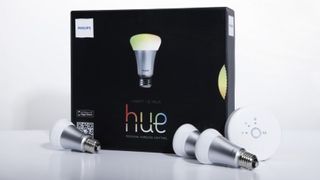What you need to consider when designing your smart home
Be in complete control of your home from anywhere
Less investment
If installing a complete smart home system isn't attractive at the moment, there are a number of projects that don't require a massive investment or technical knowledge.
Belkin has its WeMo system that offers a cost effective route to creating a smart home. If you're looking for a low-cost smart home project, WeMo could be ideal. It offers lighting automation and Wi-Fi enabled security cameras.
And if you want to get your hands dirty and do some home automation projects of your own, the WeMo Maker works with IFTTT, a service that lets you create powerful connections with one simple statement: IF this, then that. You'll be able to use any data source on the web to act as a WeMo trigger and create customised automation rules and schedules to fit your personal preferences. You can, for example, create a trigger to open the pet door for your dog at sunrise or when you log out of your work email for the day. With WeMo and IFTTT, your imagination is your only limit.
You may have already looked at the breeding remote controls scattered about your house and thought there must be a better way. With a long history in this area the Harmony remote control system from Logitech offers convenience and ease of use.
Automating your home theatre system is a great way of dipping a toe into the world of home automation. There are various models in the Harmony range, with the Harmony Ultimate offering the most functionality. And you can also control the Philips Hue range of lights with this remote too.
Thanks to a successful Kickstarter campaign, the NEEO smart home control system is based on the familiar remote control design. The remote connects to a base station that uses both Wi-Fi and Bluetooth, and also has an infrared capability to control IR devices. NEEO is also an app, which you can use instead of the remote. What's more, this remote also supports the ZigBee and Z-Wave protocols so could become the ideal controller for your smart home if you choose to use one of these platforms.

Creating your system
The level of sophistication you want across your home will determine which platform to go for. Ask yourself these two key questions:
Are you a pro? Subscribe to our newsletter
Sign up to the TechRadar Pro newsletter to get all the top news, opinion, features and guidance your business needs to succeed!
1. Do you just want to control separate systems such as lights and heating?
If so, then replacing bulbs with systems such as Philips' Hue or bulbs compatible with WeMo is a cost effective way to do this, and can be controlled with a simple app.
2. Do you want to build a system that can be extended and expanded over time?
Here your choices are a little more complex. As it's very early days with home automation there are a number of competing systems, as we've noted in this article. Currently platforms like ZigBee have a number of devices that it can connect to – but we are far from complete interoperability with standards. However, keep an eye on NEEO, as this could be the first universal system you can install.

Vint Cerf, Chief Internet Evangelist at Google, recently said: "I happen to have this sensory network running at home – these little sensors run on two AA cells and they last for about a year – each one is about the size of a mobile and its monitoring temperature, humidity and light levels in the house every five minutes and that information is transmitted to a server down in the basement.
"Now these little sensors are also network nodes – and they are forming a mesh network on their own and they change their connectivity depending on what the network linkages look like so the information is sent through the network to the target."
Having complete control of your home with nothing more than an app on your phone is certainly an attractive idea. Smart homes are coming for certain – but how you build that smart environment isn't so clear yet. Large developers like GE, Philips and of course Apple are all looking to create an out-of-the-box solution that will offer plug-and-play installation. However, until a communications standard is chosen and widely adopted, you need to carefully assess what you want to do before choosing a platform to adopt for your smart home.
- 1
- 2
Current page: Budget kits and creating your system
Prev Page Introduction and different standards
Reviews show the AMD Ryzen 7 9800X3D processor excels at productivity and creative tasks — making it a formidable rival to its Threadripper and Ryzen Pro siblings

This obscure rugged tablet beats Samsung, Apple iPad featurewise — sporting a 30,000mAh battery, dual 5G SIM and 108-megapixel camera sensor
Most Popular

